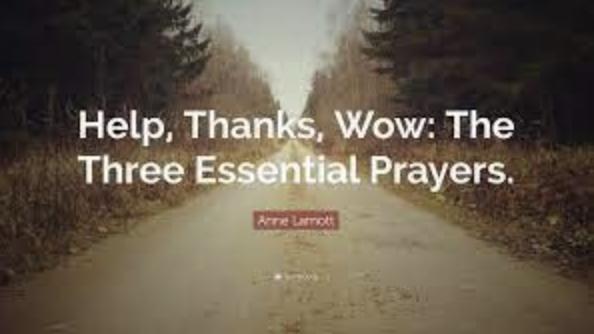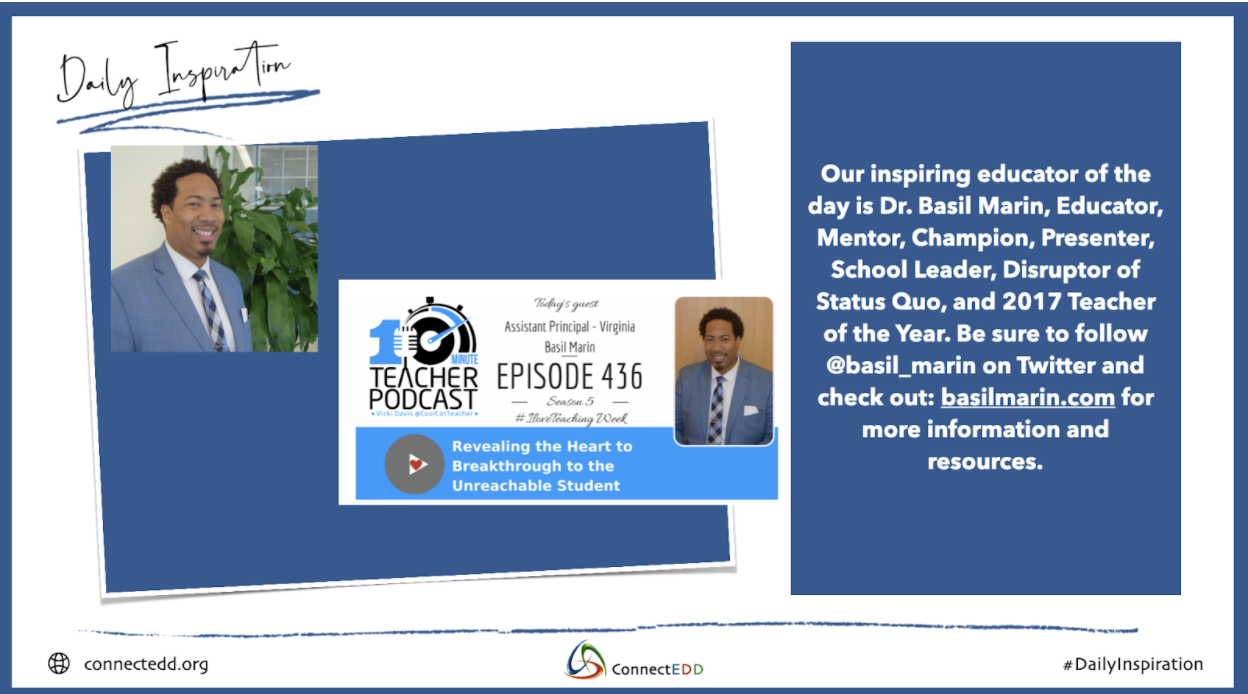CONNECTIONS: School Culture Essentials - Help. Thanks. Wow.
"The culture of a workplace--an organization's values, norms, and practices--has a huge impact on our happiness and success."
Adam Grant
I first became aware of Anne Lamott when I was teaching writing and came across her 1994 book, Bird By Bird, a thoroughly enjoyable book with helpful tips on writing and living. Recently, I read her 2012 book, Help, Thanks, Wow: The Three Essential Prayers. Although I enjoyed the book immensely, my takeaway for the purposes of this blog post has little to do with the content of this book--other than the title itself, and how that remarkable title might apply to education, specifically school culture.
At a professional learning conference a few years ago, Jimmy Casas and I were leading a session on "Building Culture and Leading Learning." During the session, I asked school leaders to reflect on what they would like others to say about their school culture, filling in the following blank with five different words:
I would like our school to be noted for its Culture of _________________ .
We brainstormed a wealth of inspiring ideas, including the hope that our schools might be marked by cultures of: Learning, Compassion, Caring, Results, Commitment, Innovation, Risk-Taking, Safety, and Excellence, to name but a few. Rather spontaneously, I thought of Lamott’s book I had recently finished and shared with the audience that I would also like to work in a school known for a culture in which Help, Thanks, and Wow were interwoven in the daily teaching, learning, leading, and living at the school. What if our schools were filled with students and staff who continuously sought help and offered it to others? Who consistently expressed gratitude for all the blessings in existence within the school community? Who never failed to express awe and wonder at the amazing things happening each day at the school? So many things are in play when we talk about "school culture." It includes the norms, attitudes, behaviors, beliefs, values, practices, celebrations, traditions, and myths that exist. Perhaps it also includes what Lamott identifies as her three simple prayers: Help. Thanks. Wow.
Essential Culture Characteristic #1: "Help." In the session we were leading recently, Jimmy made a statement I have heard him suggest on countless occasions. The four most powerful words in leadership are: “I need your help.” In a school marked by a culture of helping, we must not only embrace this sentiment, but expand upon it. Every staff member in the school and every student in the school must be comfortable seeking help from everyone else in the schoolhouse. Teachers must ask for and provide help to each other. Principals must ask for help from students and staff and provide help in return. Students must be assured that asking for help is normal and part of the school’s culture. I remember when I began my first year of teaching many years ago. I was very nervous and unsure of how to actually teach, including designing lesson plans for my first graders. During my first week of working at the school, I asked a veteran teacher if I could look at her lesson plan book so I could get some ideas for my own classroom. Although this person became a close friend who I grew to respect, I will never forget her answer. She flat out refused, telling me she had to figure it out for herself and I would have to as well. In 2019, I desperately hope this is no longer the case. No matter what your role is in a school--administrator, teacher, teacher assistant, or student--your job is tough--and made only more challenging if forced to do it alone. We must create school cultures in which asking for assistance on a regular basis without fear of repercussions is a way of life. Cultivate your “Help” culture today.
Essential Culture Characteristic #2: "Thanks." Schools with strong cultures are populated with people who genuinely appreciate all the good that is occurring therein. They take time to notice when a student helps another student, when a colleague comforts a student who is hurting, when a principal goes out of her way to celebrate staff members. They do not take these small kindnesses for granted, but, instead, take a moment to reflect on how thankful they are to be working in a school, where so much good happens so often. Moreover, they heed the advice of Gladys Bronwyn Stern’s “Silent gratitude isn't much use to anyone" admonition and share their gratitude with others. We must create school cultures in which appreciating the good we witness throughout the daily grind becomes a way of life. Cultivate your “Thanks” culture today.
Essential Culture Characteristic #3: "Wow." In schools, we are fortunate to experience hundreds of daily incidents for which we can be thankful. Perhaps even more remarkable, we work in places where awe-inspiring and legitimately wonderful things take place regularly. Things that not only make us thankful, but leave us awestruck. A student who has struggled for years to read suddenly cracks the code and becomes a voracious reader. A dedicated school nurse prevents a tragedy by acting quickly when a student experiences a medical emergency. An entire school donates their time, money, and resources to improving some aspect of the community in which they live. A student designs a product that is subsequently used in a local business. A student singing the national anthem before a basketball game brings tears to the eyes of everyone in attendance. An entire school makes time to recognize the contributions of the school custodian. Things are happening in our schools every single day which make me stop what I am doing and simply say (silently or aloud), “Wow!” We must create school cultures in which feeling awe at the amazing things happening in our schools regularly becomes a way of life. Cultivate your “Wow” culture today
I want to express my Thanks to Anne Lamott for inspiring this blog post. Her writing always Helps me and leaves me with a sense of Wow.
School culture consists of many things and, as Adam Grant suggests, has a huge impact on our happiness and success. We can behave in certain (and oftentimes simple) ways to create a culture in which that impact is profoundly positive. Three simple (and essential) ways are to follow Lamott’s advice, ensuring that we ask for assistance, appreciate the good, and recognize the awe surrounding us each day.
Creating cultures in which we seek help, express gratitude, and feel awe are more ways we create a positive and productive culture in our schools.
Thanks to all educators reading this for the amazing work you are doing during these challenging times. As always, Teach and Lead with Passion...
Jeff and Jimmy
DAILY INSPIRATION EDUCATOR
(Please let us know about an inspiring educator you think we should highlight in a future newsletter by completing this brief form!)
FEATURED BOOK!
Eyes On Culture: Multiply Excellence In Your School by Emily Paschall
In this inspirational book, Emily Paschall supplies the recipe for success in today’s schools. School culture is the hidden curriculum that drives a school forward or backward, and when strong relationships and relentless passion are at its root, this is when excellence multiplies. This book is filled with a wide range of authentic stories and lessons, as well as tangible takeaways that will culturize your classroom, school, and community. Emily provides you with the necessary tools to not only live your own excellence, but to multiply excellence in others. In this book, you will learn:
How to use your lived experiences to help someone else
How to unlock the key to connecting with all kids, even those who seem unreachable
How to build partnerships with families so that they desire to work with you
How to make difficult conversations not so difficult
How to help every student, parent, and colleague achieve excellence
Check out more here
FEATURED BOOK!
Pause. Breathe. Flourish: Living Your Best Life as an Educator by William D. Parker
In this book, Parker explores the habits, practices, and mindset necessary for growth as both an educator and a person. This book is grounded in the belief that when you invest in better care of yourself, you can better serve and lead others. Applying those insights is the challenge. Each chapter begins with a mental image and unpacks specific areas for cultivating personal or professional growth. Chapters end with reflection questions to help you take immediate actions for thoughtful application and improved outcomes. Do yourself a favor, and read ahead to pause, breathe, and flourish! Check out more here
CONNECTEDD’S TAKEAWAYS:
Thought for the Day: “Humility is not thinking less of yourself, but thinking of yourself less.” C. S. Lewis
Teaching Technique to Try: Lifted Line Poem. This activity provides a creative way for students to engage in a text after they have worked with it as a class. In a lifted line poem, students collaborate to explore more deeply the words and experiences of first-hand accounts or fictional characters. After reading a short text, students select a line that they find meaningful and, as a class, transform these lines into a poem. The class might then collaborate to rearrange their lines in a different order that reflects a shift of mood or tone or a hierarchy of emotions, for example. This activity provides students with the time and space for individual reflection about what the text means to them as they select their lines, as well as the opportunity to engage in a class discussion while debriefing the activity that focuses on the language of the text. Check out this link from Facing History and Ourselves for a step-by-step process for using this technique.
Eyes On Culture: We believe that culture is a true difference maker in any classroom, school, district, or organization. As a result, we focus much of the work we do on creating and maintaining positive and productive cultures. Culture Focus: Gratitude. High performing schools with strong cultures are places in which educators are grateful for the opportunity to work with families, each other, and most importantly, young people. Like educators everywhere, they are overworked, underpaid, and oftentimes stressed and overwhelmed. Yet, they never forget the many benefits that come with serving in the most noble profession we know: shaping the future of our society by inspiring, motivating, growing, and challenging today’s students and tomorrow’s leaders. Although there are plenty of negative aspects related to their job (whether serving as a teacher, administrator, counselor, or support staff), they make time to intentionally focus on all that is good about the role in which they serve and remain grateful for the opportunities they are given each day to make a positive difference in the lives of so many with whom they interact each day. Schools with strong cultures are populated with educators who genuinely appreciate all the good that is occurring within the school community. They not only feel grateful for their school, their colleagues, and their students, they also practice acts of gratitude, letting others know how thankful they are for the things they do. By serving with intentional gratitude, their spirit rubs off on the students they serve, increasing the likelihood that students, too, are grateful for all they are provided within the schoolhouse walls.
What are some other thoughts you have on gratitude in schools and what are you grateful for as an educator? Please share your thoughts about a culture and gratitude via Twitter: @ConnectEDDBooks We would love to hear from you!



